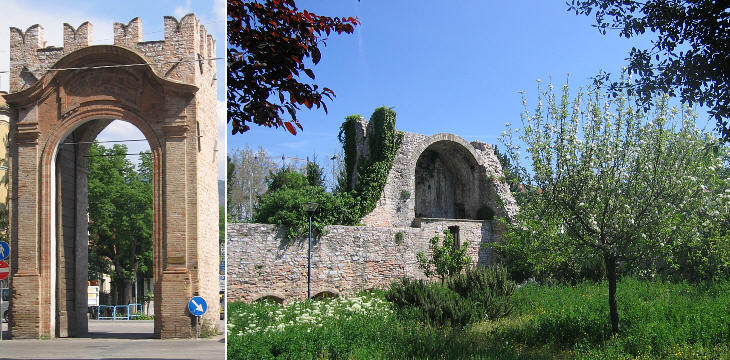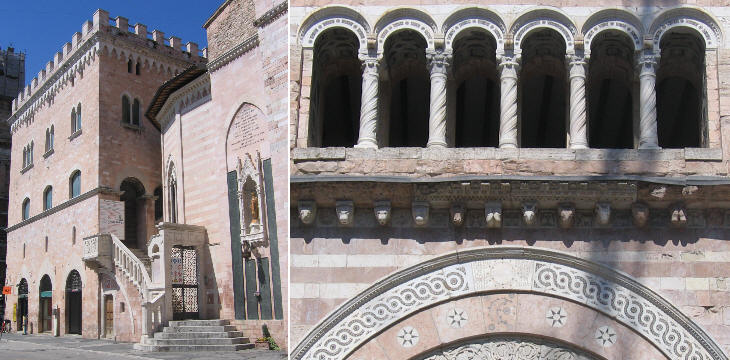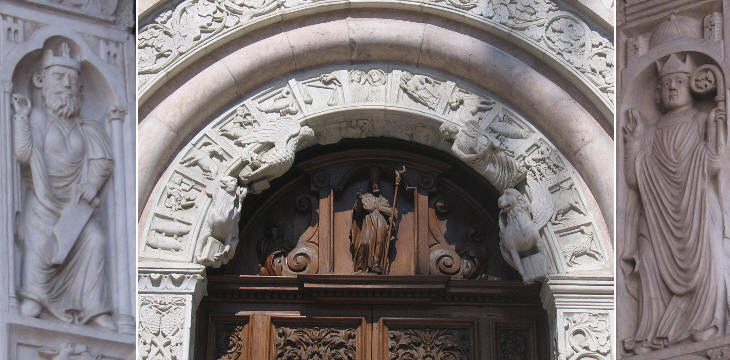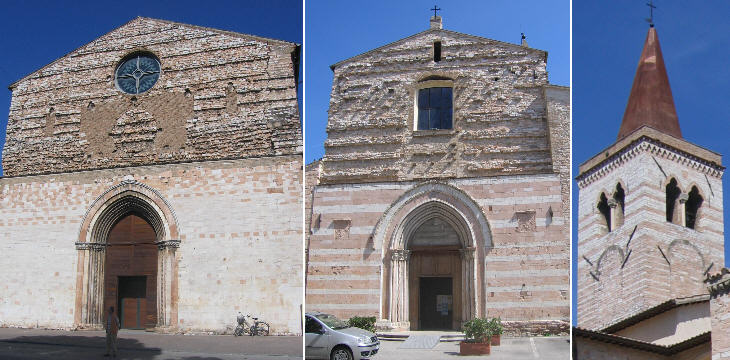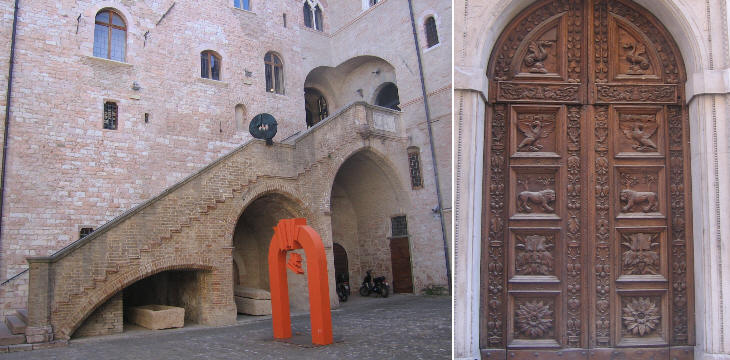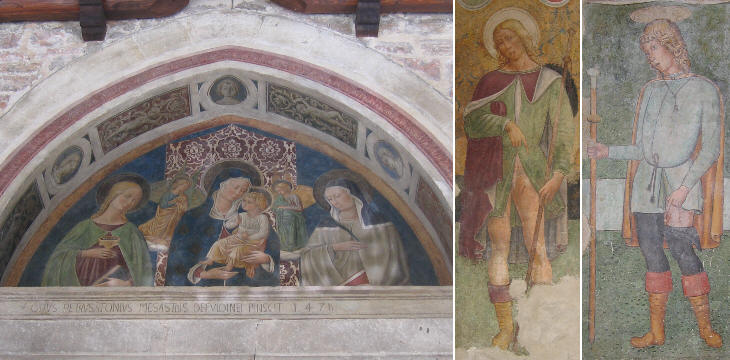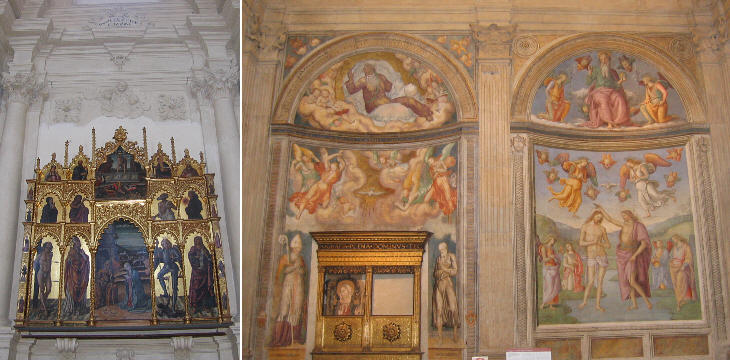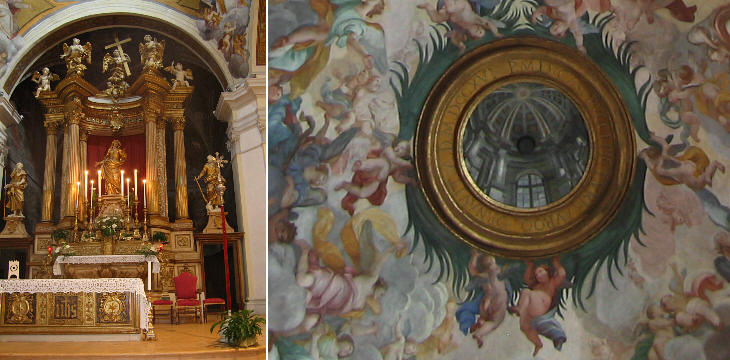  What's New! Detailed Sitemap All images © by Roberto Piperno, owner of the domain. Write to romapip@quipo.it. Text edited by Rosamie Moore. Page added in April 2007. |
8:14 from Termini Everyday a train leaves Termini at 8:14; first stop: Orte; second stop Narni; third stop Terni; fourth stop Spoleto; fifth stop Trevi; sixth stop ... 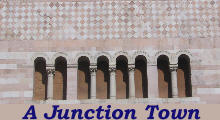 Foligno Foligno(detail of the Cathedral) The train leaves Trevi and in a few minutes it reaches Foligno which is located in the plain. During the short journey one can see Montefalco, a walled town standing on a hill to the west.
Foligno, similarly to Terni and unlike most of the towns of Umbria, was founded on a plain next to the Topino River which provided some protection. The initial settlement grew in the XIIIth century to the point that the course of the river was diverted to enlarge the town. Foligno was surrounded by walls of which only a short section still exists: also the gates were pulled down with just one exception.
The development of some towns of Umbria was frozen during the XIVth century when Cardinal Gil de Albornoz restored papal authority on the region. Their medieval monuments were not modified during the following centuries or the changes were relatively minor. Foligno followed a different path especially in the XIXth century. In 1832 an earthquake caused great damage to many buildings which were repaired without paying attention to their historical aspect. In 1866 the railway between Florence and Rome was completed (*): Foligno was the junction at which another line branched off towards Ancona. The State Railways chose the town as the location for a large maintenance workshop and the Army built barracks for training recruits because the town was within easy reach. The availability of water attracted factories and Foligno expanded well beyond the ancient walls. In the early XIXth century an effort was made to free the remaining medieval buildings from later modifications, but in some cases dubious additions were made, such as the steps of Palazzo delle Canoniche. WWII caused significant damage and the post-war reconstruction effort was a hasty one so the medieval heritage of Foligno is better represented by details, rather than by whole buildings.
The Cathedral was redesigned in the XVIth century and the main portal became a side entrance: its 1201 reliefs portray the then ruling Emperor and Pope, in addition to religious and astronomical symbols (sun, moon, constellations).
The most typical feature of Foligno's medieval churches is the use of white and pink stones: the image used as background for this page shows a decoration based on this combination of colours which can be seen on the right side of the cathedral.
The Trinci family supported Cardinal Albornoz' efforts to restore papal authority in the region and they were rewarded by Pope Urban V with the lordship of Foligno; their palace was badly damaged by the 1832 earthquake and its façade was rebuilt in Neoclassic style. The courtyard retains its medieval appearance and in particular the Gothic steps leading to the palace main halls. In 1439 Pope Eugenius IV put an end to the Trinci lordship and the town was directly ruled by papal officers. Even during that period, some families were wealthy enough to pay for the decoration of their houses, as shown by the Renaissance wooden panels of Palazzo Deli.
In 1450 the Florentine painter Benozzo Gozzoli was asked by the Franciscan Abbot of Montefalco to embellish his monastery with frescoes. Gozzoli who is best known for his elegant and very coloured frescoes at Palazzo Medici in Florence (external link) influenced the local painter Pier Antonio Mezzastris who decorated some churches of Foligno. Pestilences were a recurring calamity in those days and this explains the devotion to S. Rocco; this saint died during a plague while he was taking care of the sick: he is portrayed showing a sore on his thigh, the symptom of the disease.
The churches of Foligno have many interesting Renaissance paintings: the polyptych at S. Nicolò was shipped to Paris in 1808 when the Papal State was annexed to the French Empire. In 1817 Pope Pius VII managed to obtain its return, but King Louis XVIII kept for the Louvre the predella, the appendage to the altarpiece.
Foligno followed the artistic developments of Rome and the interior of some of its churches were redesigned in Baroque style: the ceiling of S. Agostino was decorated with a fake dome, a feature which became very popular after Andrea Pozzo designed that of S. Ignazio in Rome. Make an excursion to Montefalco, move on to Spello or branch off the main line to visit Nocera, Gualdo Tadino and Gubbio. (*) A more direct route between Florence and Rome was opened some years later. 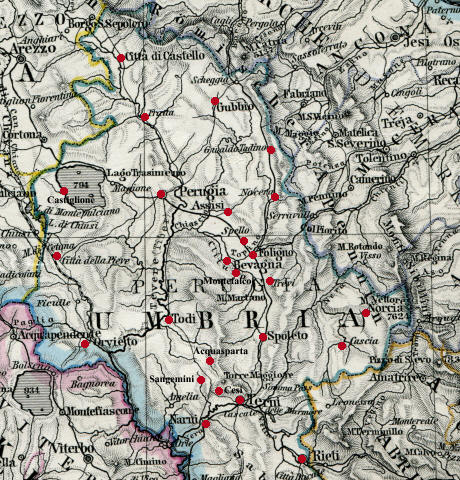
1864 clickable map of Umbria |
